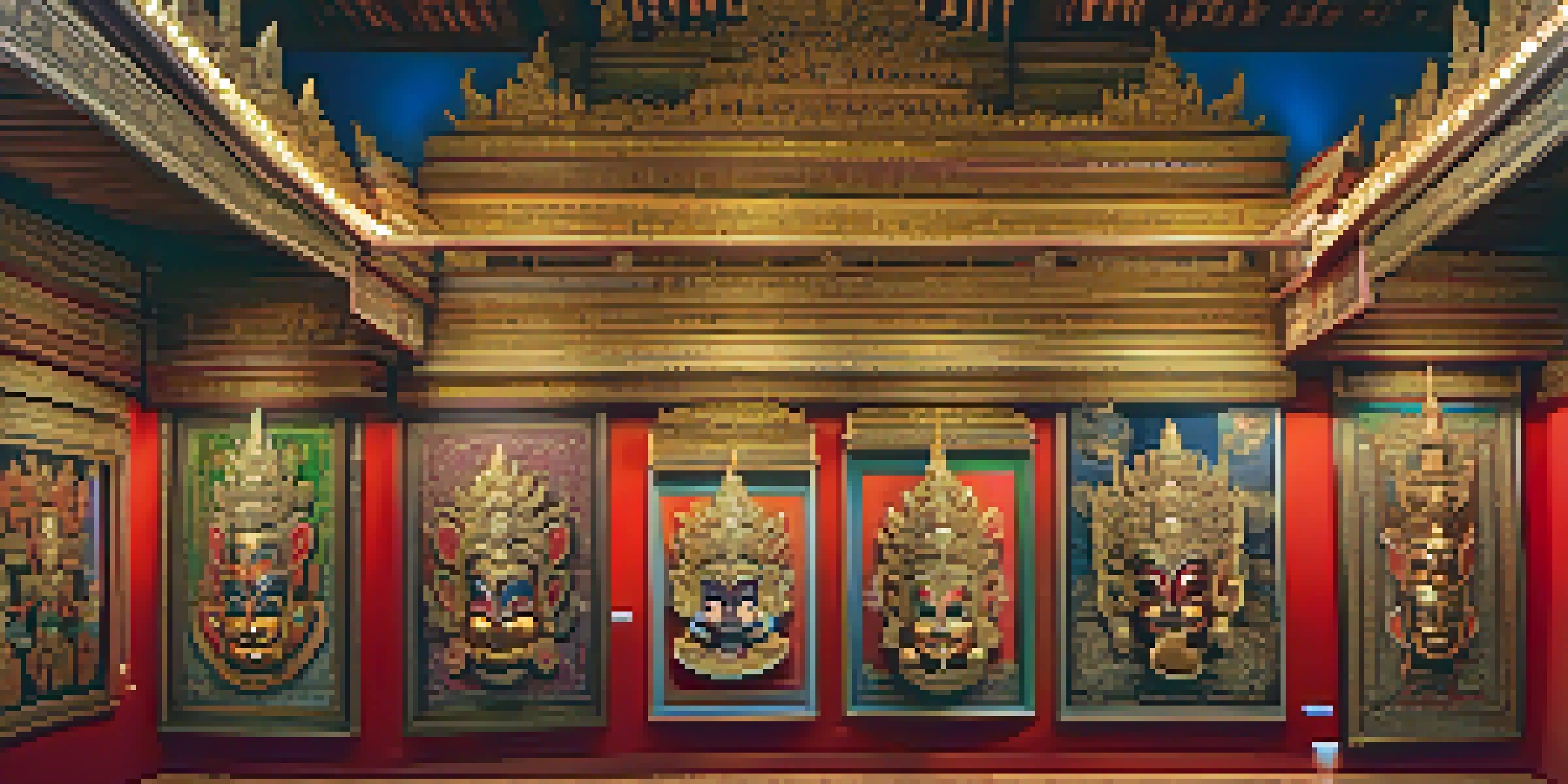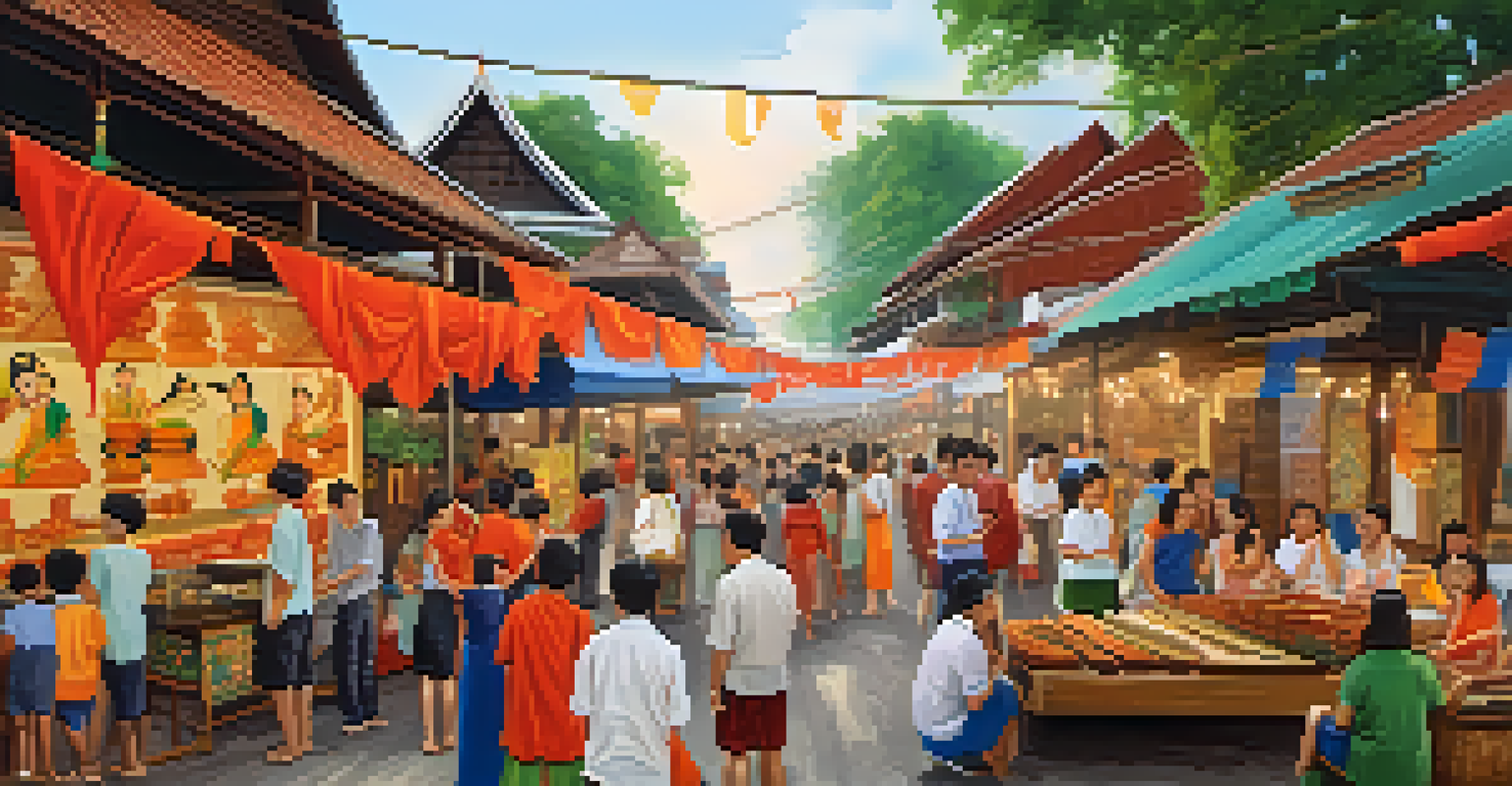Traditional Thai Art Galleries: Preserving Cultural Heritage

The Essence of Traditional Thai Art
Traditional Thai art is a vibrant reflection of the country's rich history and culture. From intricate temple murals to beautifully crafted sculptures, each piece tells a story that connects past and present. The artistry often incorporates elements of Buddhism, nature, and the everyday life of Thai people, making it both spiritual and relatable.
Art is the most beautiful of all lies.
One of the most recognized forms of Thai art is the 'khon' mask, used in traditional dance performances. These masks are not merely decorative; they embody characters from Thai mythology. Each detail—color, shape, and design—carries significant meaning, highlighting the depth of cultural narratives woven into art.
By visiting art galleries, one can appreciate the meticulous craftsmanship and learn about the cultural significance behind various artworks. These galleries serve as gateways to understanding the soul of Thailand, inviting both locals and tourists to engage with the nation's artistic heritage.
Role of Galleries in Cultural Preservation
Art galleries play a crucial role in preserving traditional Thai art for future generations. They provide a sanctuary for artworks that might otherwise be lost to time or modern influences. By curating collections of traditional pieces, these galleries help maintain a continuity of cultural practices and artistic expression.

In addition to preservation, galleries often host workshops and educational programs. These initiatives engage the community and foster appreciation for traditional techniques among younger generations. Imagine a child learning how to create their own 'nielloware'—a traditional Thai craft—that connects them to their heritage.
Cultural Heritage Through Art Galleries
Art galleries play a crucial role in preserving traditional Thai art and fostering community engagement.
Moreover, galleries serve as platforms for artists to showcase their work and gain recognition. This not only supports the artists but also ensures that traditional art forms continue to evolve and adapt while retaining their cultural roots.
Impact of Modernization on Thai Art
As Thailand embraces modernization, traditional art faces both challenges and opportunities. While contemporary art forms gain popularity, there is a risk that traditional methods and styles may fade into obscurity. However, this shift also encourages artists to blend traditional techniques with modern concepts, creating a unique fusion that appeals to diverse audiences.
The greatest art is to sit, wait and let it come.
Many galleries are rising to this challenge, showcasing both traditional and contemporary works. This approach not only honors cultural heritage but also stimulates discussions about the evolution of Thai art. For instance, a gallery may feature a traditional 'batik' alongside a modern interpretation, sparking curiosity about how culture can adapt.
By fostering these interactions, galleries contribute to a dynamic art scene that respects tradition while inviting innovation. This balance is vital for keeping Thai art relevant in an ever-changing world.
Community Engagement in Art Galleries
Community involvement is essential for the vitality of traditional Thai art galleries. Many galleries invite local artists to exhibit their work, creating a sense of ownership and pride within the community. This connection not only enriches the gallery's offerings but also strengthens ties among residents who share a passion for their cultural heritage.
Furthermore, these spaces often host cultural events, such as festivals or art fairs, that celebrate traditional practices. Picture a bustling gallery filled with laughter, music, and the aroma of Thai cuisine during a local art festival—it's a beautiful way to engage people with their culture.
Modernization's Impact on Tradition
While modernization poses challenges to traditional art, it also encourages innovative blends of old and new styles.
Through these activities, galleries become living entities that reflect the pulse of the community. They encourage dialogue, collaboration, and a collective appreciation for the art that defines Thai identity.
Prominent Traditional Thai Art Galleries
Several galleries across Thailand stand out for their commitment to preserving traditional art. The National Gallery in Bangkok, for example, showcases an impressive collection of Thai paintings and sculptures, highlighting the evolution of artistic styles over the years. It's a must-visit for anyone wanting to delve deeper into the nation's artistic journey.
Another notable gallery is the Museum of Contemporary Art in Bangkok, which, despite its focus on modern art, features sections dedicated to traditional Thai works. This blend of old and new illustrates the ongoing conversation between different artistic eras, inviting visitors to appreciate both.
Lastly, the Chiang Mai Art Museum is renowned for its dedication to local artisans. It provides a platform for artists from the northern region to share their work, ensuring that the unique cultural elements of Northern Thai art are preserved and celebrated.
Challenges Facing Traditional Art Galleries
Despite their vital role, traditional art galleries face several challenges. Limited funding can hinder their ability to curate extensive collections or host workshops that enrich community engagement. Many rely heavily on government support or donations, which can be unpredictable and restrictive.
Moreover, the rise of digital media poses a challenge to traditional galleries. As more people turn to online platforms for art appreciation, galleries must find innovative ways to attract visitors. This has led some galleries to develop virtual tours or online exhibitions, allowing them to reach a broader audience while maintaining their physical presence.
Future of Thai Art is Promising
Growing appreciation among younger generations and international collaborations can ensure the vibrancy of traditional Thai art.
Adapting to these challenges is crucial for galleries to thrive. By embracing technology while staying true to their mission of preserving cultural heritage, they can continue to serve as essential spaces for artistic expression.
The Future of Traditional Thai Art and Galleries
The future of traditional Thai art and its galleries is filled with potential. As awareness of the importance of cultural heritage grows, there is an increasing appreciation for traditional art forms among younger generations. This renewed interest can lead to a resurgence in traditional practices, ensuring that they are not lost to time.
Additionally, collaborations between local artists and international galleries can help elevate Thai art on a global stage. Imagine Thai artisans showcasing their work alongside international artists, exchanging ideas and techniques—this cross-cultural dialogue can enrich both local and global art scenes.

By fostering these connections and encouraging innovative approaches to traditional art, galleries can ensure that Thai culture remains vibrant and relevant in the years to come. The journey of preserving and celebrating Thai art is ongoing, and each gallery plays a vital part in this narrative.